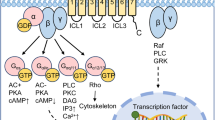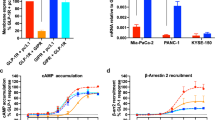Abstract
Aim:
GPR119 is a G protein-coupled receptor (GPCR) that is highly expressed in pancreatic β-cells and intestinal L-cells and facilitates glucose-stimulated insulin secretion (GSIS). GPR119 may represent a novel target for the treatment of metabolic disorders. Here, we sought to identify novel small-molecule GPR119 agonists.
Methods:
A cell-based high-throughput screening assay was established using HEK293 cells stably expressing GPR119 and pCRE-luc reporter plasmid (HEK293/GPR119/pCRE-luc). A compound library composed of 1440 compounds was screened. Mouse β-cell line MIN-6 and isolated mouse islets were used to evaluate the effects of candidate compounds on GSIS in vitro.
Results:
Three compounds with novel structures (ZSY-04, -06, and -13) were found to activate GPR119-mediated signaling and to induce GPR119 desensitization. The EC50 values of ZSY-04, -06, and -13 in stimulating intracellular cAMP accumulation in HEK293/GPR119 cells were 2.758, 3.046, and 0.778 μmol/L, respectively. Furthermore, all three compounds displayed high selectivity for GPR119, and did not activate other 9 GPCRs tested. Moreover, all three compounds significantly increased GSIS in both MIN-6 mouse β-cells and isolated mouse islets at concentration of 10 μmol/L.
Conclusion:
Three novel small-molecule GPR119 agonists (ZSY-04, -06, and -13) with high receptor selectivity and capacity to induce GSIS in vitro were discovered. These compounds are potential candidates to be structurally optimized into drugs for the treatment of type 2 diabetes.
Similar content being viewed by others
Log in or create a free account to read this content
Gain free access to this article, as well as selected content from this journal and more on nature.com
or
References
Verspohl EJ . Novel pharmacological approaches to the treatment of type 2 diabetes. Pharmacol Rev 2012; 64: 188–237.
Paciorek CJ, Lin JK, Farzadfar F, Khang YH, Stevens GA, Rao M, et al. National, regional, and global trends in fasting plasma glucose and diabetes prevalence since 1980: systematic analysis of health examination surveys and epidemiological studies with 370 country-years and 2.7 million participants. Lancet 2011; 378: 31–40.
Nadeau DA . Physiologic and weight-focused treatment strategies for managing type 2 diabetes mellitus: the metformin, glucagon-like peptide-1 receptor agonist, and insulin (MGI) approach. Postgrad Med 2013; 125: 112–26.
Organization. WH. Global health risks: mortality and burden of disease attributable to selected major risks. Geneva: World Health Organization 2009.
Organization. WH. Global status report on non-communicable diseases. WHO: Geneva, Switzerland 2010.
Milligan G, Stoddart LA, Brown AJ . G protein-coupled receptors for free fatty acids. Cell Signal 2006; 18: 1360–5.
Hirasawa A, Hara T, Katsuma S, Adachi T, Tsujimoto G . Free fatty acid receptors and drug discovery. Biol Pharm Bull 2008; 31: 1847–51.
Suzuki T, Igari S, Hirasawa A, Hata M, Ishiguro M, Fujieda H, et al. Identification of G protein-coupled receptor 120-selective agonists derived from PPARgamma agonists. J Med Chem 2008; 51: 7640–4.
Li C, Jones PM, Persaud SJ . Cannabinoid receptors are coupled to stimulation of insulin secretion from mouse MIN6 beta-cells. Cell Physiol Biochem 2010; 26: 187–96.
Kuna RS, Girada SB, Asalla S, Vallentyne J, Maddika S, Patterson JT, et al. Glucagon-like peptide-1 receptor-mediated endosomal cAMP generation promotes glucose-stimulated insulin secretion in pancreatic beta-cells. Am J Physiol Endocrinol Metab 2013; 305: E161–70.
Sakamoto Y, Inoue H, Kawakami S, Miyawaki K, Miyamoto T, Mizuta K, et al. Expression and distribution of Gpr119 in the pancreatic islets of mice and rats: predominant localization in pancreatic polypeptide-secreting PP-cells. Biochem Biophys Res Commun 2006; 351: 474–80.
Chu ZL, Jones RM, He H, Carroll C, Gutierrez V, Lucman A, et al. A role for beta-cell-expressed G protein-coupled receptor 119 in glycemic control by enhancing glucose-dependent insulin release. Endocrinology 2007; 148: 2601–9.
Chu ZL, Carroll C, Alfonso J, Gutierrez V, He H, Lucman A, et al. A role for intestinal endocrine cell-expressed G protein-coupled receptor 119 in glycemic control by enhancing glucagon-like peptide-1 and glucose-dependent insulinotropic peptide release. Endocrinology 2008; 149: 2038–47.
Soga T, Ohishi T, Matsui T, Saito T, Matsumoto M, Takasaki J, et al. Lysophosphatidylcholine enhances glucose-dependent insulin secretion via an orphan G-protein-coupled receptor. Biochem Biophys Res Commun 2005; 326: 744–51.
Ning Y, O'Neill K, Lan H, Pang L, Shan LX, Hawes BE, et al. Endogenous and synthetic agonists of GPR119 differ in signalling pathways and their effects on insulin secretion in MIN6c4 insulinoma cells. Br J Pharmacol 2008; 155: 1056–65.
Lan H, Vassileva G, Corona A, Liu L, Baker H, Golovko A, et al. GPR119 is required for physiological regulation of glucagon-like peptide-1 secretion but not for metabolic homeostasis. J Endocrinol 2009; 201: 219–30.
Lauffer LM, Iakoubov R, Brubaker PL . GPR119 is essential for oleoylethanolamide-induced glucagon-like peptide-1 secretion from the intestinal enteroendocrine L-cell. Diabetes 2009; 58: 1058–66.
Jones RM, Leonard JN, Buzard DJ, Lehmann J . GPR119 agonists for the treatment of type 2 diabetes. Expert Opin Ther Pat 2009; 19: 1339–59.
Li DS, Yuan YH, Tu HJ, Liang QL, Dai LJ . A protocol for islet isolation from mouse pancreas. Nat Protoc 2009; 4: 1649–52.
Zhu T, Fang LY, Xie X . Development of a universal high-throughput calcium assay for G-protein-coupled receptors with promiscuous G-protein Galpha15/16. Acta Pharmacol Sin 2008; 29: 507–16.
Winzell MS, Ahren B . G-protein-coupled receptors and islet function-implications for treatment of type 2 diabetes. Pharmacol Ther 2007; 116: 437–48.
Ahren B . Islet G protein-coupled receptors as potential targets for treatment of type 2 diabetes. Nat Rev Drug Discov 2009; 8: 369–85.
Morgan NG, Dhayal S . G-protein coupled receptors mediating long chain fatty acid signalling in the pancreatic beta-cell. Biochem Pharmacol 2009; 78: 1419–27.
Shah U . GPR119 agonists: a promising new approach for the treatment of type 2 diabetes and related metabolic disorders. Curr Opin Drug Discov Devel 2009; 12: 519–32.
Semple G, Fioravanti B, Pereira G, Calderon I, Uy J, Choi K, et al. Discovery of the first potent and orally efficacious agonist of the orphan G-protein coupled receptor 119. J Med Chem 2008; 51: 5172–5.
Overton HA, Babbs AJ, Doel SM, Fyfe MC, Gardner LS, Griffin G, et al. Deorphanization of a G protein-coupled receptor for oleoylethanolamide and its use in the discovery of small-molecule hypophagic agents. Cell Metab 2006; 3: 167–75.
Yoshida S, Ohishi T, Matsui T, Shibasaki M . Identification of a novel GPR119 agonist, AS1269574, with in vitro and in vivo glucose-stimulated insulin secretion. Biochem Biophys Res Commun 2010; 400: 437–41.
Yoshida S, Ohishi T, Matsui T, Tanaka H, Oshima H, Yonetoku Y, et al. Novel GPR119 agonist AS1535907 contributes to first-phase insulin secretion in rat perfused pancreas and diabetic db/db mice. Biochem Biophys Res Commun 2010; 402: 280–5.
Yoshida S, Tanaka H, Oshima H, Yamazaki T, Yonetoku Y, Ohishi T, et al. AS1907417, a novel GPR119 agonist, as an insulinotropic and beta-cell preservative agent for the treatment of type 2 diabetes. Biochem Biophys Res Commun 2010; 400: 745–51.
Yoshida S, Ohishi T, Matsui T, Tanaka H, Oshima H, Yonetoku Y, et al. The role of small molecule GPR119 agonist, AS1535907, in glucose-stimulated insulin secretion and pancreatic beta-cell function. Diabetes Obes Metab 2011; 13: 34–41.
Katz LB, Gambale JJ, Rothenberg PL, Vanapalli SR, Vaccaro N, Xi L, et al. Pharmacokinetics, pharmacodynamics, safety, and tolerability of JNJ-38431055, a novel GPR119 receptor agonist and potential antidiabetes agent, in healthy male subjects. Clin Pharmacol Ther 2011; 90: 685–92.
Nunez DJ, Lewis EW, Swan S, Bush MA, Cannon C, McMullen SL, et al. A study in healthy volunteers to assess the safety, tolerability, pharmacokinetics(PK) and pharmacodynamics (PD) of single and multiple doses of GSK1292263, a novel GPR119 agonist. 70th Annual Meeting and Scientific Sessions of the American Diabetes Association 2010.
Roberts B, Gregoire FM, Karpf DB, Clemens ED, Lavan B, Johnson J, et al. MBX-2982, a novel oral GPR119 agonist for the treatment of type 2 diabetes: results of single & multiple dose studies. American Diabetes Association 2009.
Acknowledgements
This project was supported by grants from the Ministry of Science and Technology of China (2013ZX09507001, 2012ZX09301001-005, and 2014CB541906), the National Natural Science Foundation of China (81202341), and the Shanghai Commission of Science and Technology (12XD1402100 and 11ZR1408000).
Author information
Authors and Affiliations
Corresponding author
Rights and permissions
About this article
Cite this article
Zhang, Sy., Li, J. & Xie, X. Discovery and characterization of novel smallmolecule agonists of G protein-coupled receptor 119. Acta Pharmacol Sin 35, 540–548 (2014). https://doi.org/10.1038/aps.2014.8
Received:
Accepted:
Published:
Issue date:
DOI: https://doi.org/10.1038/aps.2014.8



